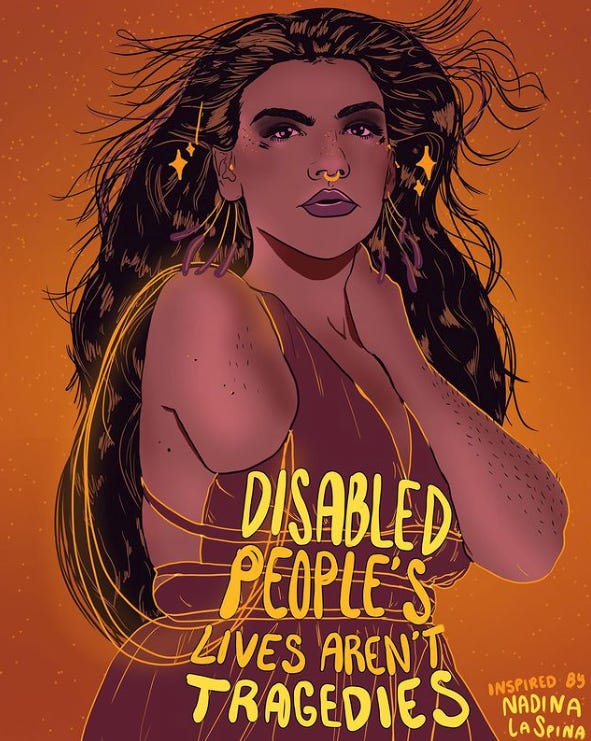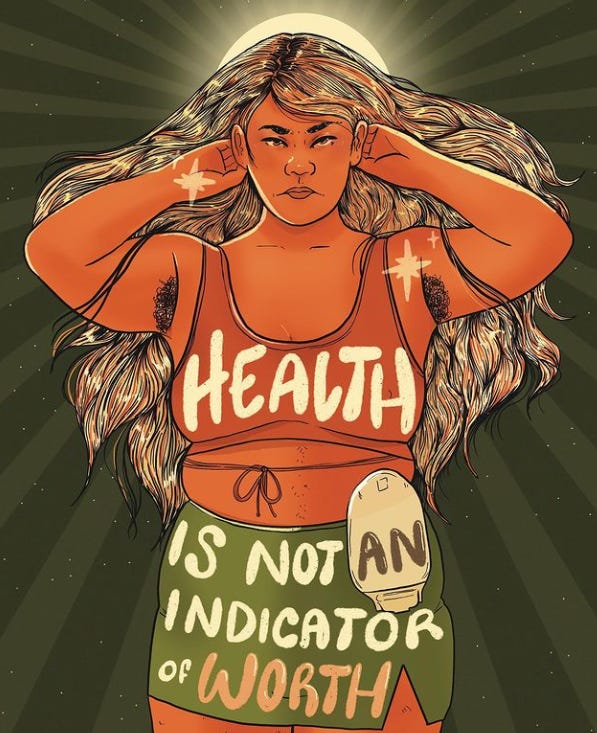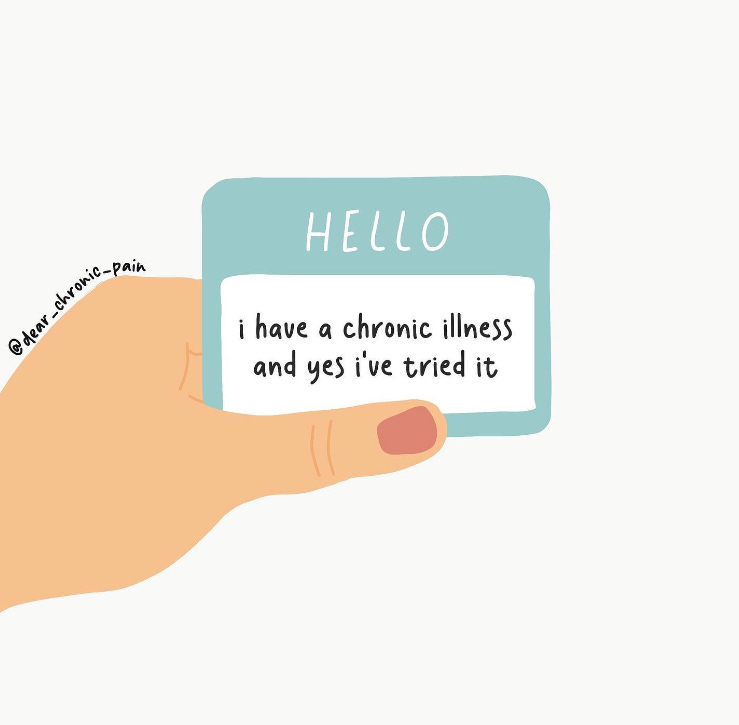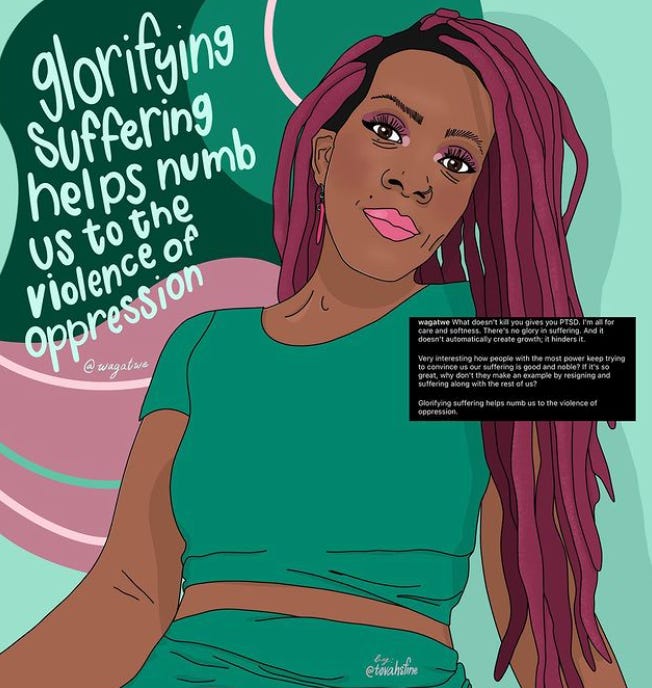Disability is not a dirty word
What disability is, how to talk about it, and how to make your content more accessible.
“Don’t say disability, that’s sooo negative. Why not say special needs, differently-abled, or handi-capable?”
Heard that before? I have.
And as a disabled person, it pisses me off.
Phrases like “special needs” are euphemisms. Euphemisms sugar-coat ideas that we think are shameful. But there’s nothing wrong with disability.
Disability is not a dirty word. You can #SayTheWord.

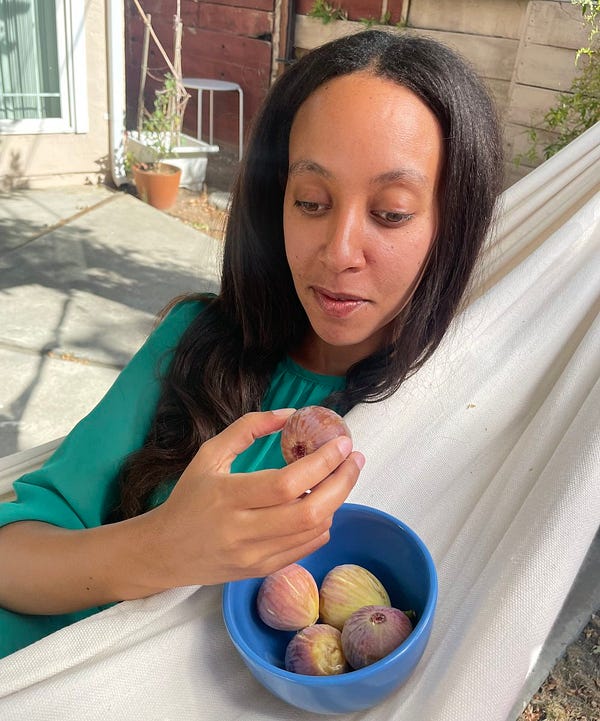
In this newsletter, we’ll cover:
What disability is.
What accessibility is.
How to make your content more accessible.
It’s another long read (about 7 minutes). So grab a drink and a snack and get cosy.
What disability is
If you think disabilities are in the body, that’s the medical model of disability. It says:
People are disabled by cognitive, physical or motor differences or impairments.
The “problem” is in their body.
People can be mildly or severely disabled, depending on how far their body is from a “normal” body (normal tends to mean an idealised White, European, cisgender man’s body).
Personally, not a fan. Because disability is contextual. You can feel highly disabled in one setting, and not at all disabled in another setting. That’s why I love the social model.
The social model of disability says:
People are disabled by structures. A wheelchair user is disabled by design choices, like buildings without ramps.
The problem is social systems, not people’s bodies.
Disability is a mismatch between a person and the environment they’re in.
One more time: the person isn’t the problem. The problem is the mismatch between them and their environment.

Disability is common
You’d think disability was rare – and terrible – from the stories we tell. We dehumanise disabled people through inspiration porn. Or code them as villains and monsters.
But disability is common! It’s a normal part of human experience.
More than 1 in 5 of us are disabled. And when we count mental health conditions as disabilities (which we should), that rises to more like 1 in 4 of us.
Ableism is tragic, not disability
Globally, most disabled people are unemployed or underemployed.
In some places, disabled people can’t marry or live with a partner (without losing essential support), and it’s legal to pay disabled people less than non-disabled people.
Disabled people are at much higher risk of violence than non-disabled people.
That’s shameful. But it’s ableism that’s shameful, not being disabled.
Disability affects nearly everyone
Let’s say you’re non-disabled (abled). It’s probably not forever. If you’re lucky enough to live into old age, you’ll experience disability. It’s probably more accurate to say you’re temporarily non-disabled (or abled).
Impairment affects everyone
If you’re non-disabled now, you still experience temporary and situational impairments.
Maybe, like me, you watch TV while texting while tweeting while internet shopping.

Almost half of us text while on the toilet (sorry). We can do that because of accessible UX design – we don’t need two hands available to text.
An impairment isn’t necessarily a problem, until design disables us.
Just like being blind isn’t a problem, until we’re disabled by images with no alt text.
Accessibility helps everyone
Ever spoken to a voice assistant like Siri, pressed a touchscreen button, or used cruise control?
They were all designed by and for disabled people, then went mainstream. It’s called the curb cut effect.
Read my longer article about disability for more on the curb cut effect, and why disabled people are ingenious creators and dreamers – definitely not passive recipients of accessibility “help.”
How to talk about disability
There are two main ways to talk about disability (and other parts of identity):
Person-first language, and
Identity-first language.
Person-first language
Person-first language looks like this:
I’m a person with disabilities.
Elena, a person who is Deaf.
They have hypermobility.
Identity-first language
Identity-first language looks like this:
I’m disabled.
Elena’s Deaf.
They’re hypermobile.
In some parts of the world, like Australia, South Africa and the USA, person-first language is strongly preferred (with big exceptions, like autistic, blind and Deaf/deaf people).
In the UK, where I live, most disabled people use identity-first language.
Identity-first language
Some people use identity-first language (“disabled person”) because it shows:
How important your disability is (“disabled” comes first).
You can’t separate your disability from who you are.
There’s nothing to be ashamed of or distance yourself from.
Being disabled is something you “are”, not something you “have.”
Person-first language
Some people use person-first language (“person with disabilities”) because it shows:
You are a person first (“person” comes first, followed by your condition or disability)
Your disability doesn’t define you.
A disability is something you “have”, not something you “are.”
Two different approaches. Both totally valid.
Why I use identity-first language
Personally, identity-first language (“I’m disabled”) feels more accurate to me when talking about disability.
No criticism if you use person-first language, it’s just not my choice.
To me, person-first language (“person with disabilities”) sounds like saying: “they’re a person and – gasp - they’re also disabled. What a shame.”
As Lydia X. Z. Brown says:
“What we are saying when we say "person with autism" is that the person would be better off if not Autistic, and that it would have been better if he or she had been born typical.
"If you have to put the word 'person' first to remind yourself that we're people, you really have a problem, not us […] If you have to go through linguistic gymnastics to remind yourself that we're people, you already didn't believe we were people.”
Disabled people don’t need humanising.
We don’t all agree on how to talk about disability (or, you know, anything). So how do you figure out what to say?
Ask people
Between 75 and 90% of autistic people in the UK prefer identity-first language (“she’s autistic”) not “she has autism”), to take just one example.
That’s important to know, but it doesn’t tell us what everyone wants.
If you’re talking about a specific person, ask them.
Let people tell their own stories
Why write about people, if they can speak for themselves?
Make sure disabled people tell their own stories (if they want to).
Explain why
If you’re writing about all of the 1 billion disabled people around the world, you can’t ask them all.
Make a choice, and be willing to explain why you made it.
Centre the wants and needs of relevant people. Talk to people in relevant places, with the relevant disabilities, identities or conditions you’re talking about.
Steer clear of heroes and inspiration
Disabled people are not your inspiration porn. Try not to call disabled people heroes, just for being disabled.
Disabled bodies are good bodies
What’s the opposite of disabled?
Non-disabled, or
Abled.
I don’t say “able-bodied” personally. Disabled bodies are perfectly good bodies.
Oh, and while we’re doing definitions:
Disablism = discrimination against disabled people.
Ableism = discrimination in favour of non-disabled people.
#A11y is shorthand for accessibility.
Now for some practical actions.
10 ways to make your content more accessible
1. Make your insults more creative
If you don’t like something or someone, there are wayyy better ways to insult them than to bring disability into the picture.
Using disability as a shorthand for things you don’t like is ableist.
Also, really boring.
Instead of bipolar.
Try: Unpredictable, chaotic, changeable, mercurial.
Instead of insane.
Try: Wild, bizarre, full-on, unbelievable.
Instead of: my psycho ex-girlfriend.
Try: a woman with healthy boundaries?
Swap out clichés that associate disability with ignorance or failure (like “blind spot”, “his comments fell on deaf ears”, or “can I get a sanity check?”).
Say exactly what you mean instead (“I missed that”, “no one listened to him”, “is this clear?”).
➡️ Read Lydia X. Z. Browns’s list of ableist terms and what to say instead.
2. Be accurate.
People aren’t “confined” to wheelchairs - it’s more accurate to say they’re liberated by them. It’s pretty patronising to say people “suffer” from their disabilities. And “victim” is misleading (it can sound like someone has died). Use clear, standard language instead.
Do say: Uses a wheelchair, has Parkinson’s, has cancer, had a stroke/is a stroke survivor.
Don’t say: Confined to a wheelchair, afflicted with Parkinson’s, a cancer victim, suffered a stroke.
3. Go easy with the emojis
Many blind and partially sighted people use screenreaders (assistive software that reads written content aloud, or converts it to braille). Imagine you get this text:
“Good morning! Waving hand light skin tone slightly smiling face nerdy face with thick horn-rimmed glasses and buck teeth red heart winking face with stuck-out tongue.”
It’s enough to make you feel loudly crying face emoji.
One emoji is enough (don’t repeat the same emoji again and again).
Put emojis at the beginning like a bullet point, or at the end after calls to action, so people hear the important bit first. Don’t put them in middle.
4. Always include alt text
Images without alt text (or image descriptions) disable people.
Alt text helps everyone, including sighted people, because it shows up if an image doesn’t load properly, and also boosts SEO.
Start paying attention to alt text, even if you don’t need it. Check out awe-inspiring examples like NASA’s Webb telescope images.
Show the vibe, not just the facts. Learn from Haben Girma’s gorgeous alt text. It’s not just Aubrie in her wheelchair, but “Aubrie’s black throne of a power wheelchair.”
Read Amy Kavanagh’s tips for writing great alt text.
Give people equal access to information. If you don’t mention race or gender presentation in your alt text, many users will assume assume people are White (or other default dominant identities).
On Twitter, turn on alt text reminders.
5. Write unique and descriptive hyperlinks
Hyperlinks should be unique and descriptive. They need to tell readers where they will go, and what they will get.
Do say: Read this guide to writing great link text.
Don’t say: Click here.
6. Use camel case for hashtags
Capitalise the first letter of each word in a hashtag.
If you don’t, screen-readers will read every single letter out individually. And they won’t know if you meant #BeanAlly, #BeAnally, or #BeAnAlly. Awkward.
Make your tweets more accessible in seconds!
Use #CamelCase for hashtags.
You capitalise the first letter of each word.
Screen-readers can identify each word (not a string of letters) so it’s easier to read and helps neurodivergent folks.
Instead of #beanally
Write: #BeAnAlly
7. Caption your videos
Describe important sounds and music (not just words), and make sure the captions are synchronised with the video.
Over-captioning can exclude people, so don’t go overboard.
Meryl Evans writes about this brilliantly in her exploration of how Stranger Things went too far with their captions.
8. Format properly
If you use bold text or different fonts to signify a heading, screenreaders won’t recognise it. It looks like a chunk of normal text.
This stops blind and partially sighted people from scanning the page (by generating a list of subheadings and skipping through them). It’s also harder for everyone to read, and worse for SEO.
9. Write for dyslexia
Use dyslexia friendly fonts (sans serif, minimum size 12). Watch out for double spaces, and avoid capitals and italics.
Check out the British Dyslexia Association’s Dyslexia Style Guide (opens as PDF).
10. Keep learning
Unlearning ableism is a journey. Surround yourself with new stories, and keep learning.
Read my longer article about accessible communication, to find out:
what Lizzo and Beyoncé tell us about the overlap of racism with ableism,
what typewriters have to do with disability, and
why self-description may not be as useful as you think.
Want to work with me?
Email me on hello@fightingtalk.uk if you’d like to book a training workshop about inclusive language or accessible communication.



